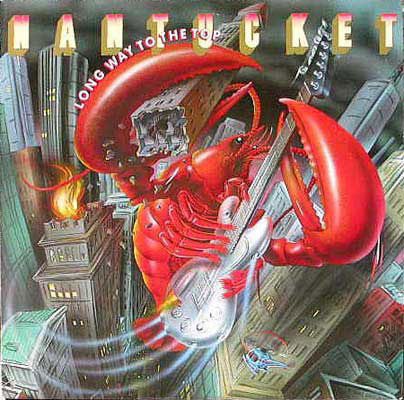It seems like every mainstream artist is releasing a vinyl record these days. As an alternative to streaming services with excellent fan appeal, vinyl seems like a new and burgeoning market. And while it is certainly burgeoning, it obviously isn’t a new industry at all.
To me, used vinyl is the perfect musical search engine. Walk into a used record store, pick up an album for ten bucks based purely on the cover, and walk out with something you might just end up adding to a few playlists. One of my latest and favorite pickups with this strategy was Nantucket’s “Long Way to The Top.”
Nantucket is a rock band formed in North Carolina in 1969. And “Long Way to the Top” is their third release. It was released in 1980 and featured a cover of the eponymous AC/DC song as a tribute to their lead singer Bon Scott, who had died that year. Nantucket’s tribute didn’t go unnoticed, and they ended up with a spot on AC/DC’s “Back in Black” tour that summer.
The cover itself is an admirable one, though it lacks a bit of the hard rock je ne sais quoi that the original boasted. The rest of the album swiftly changes gears, moving into a more classic rock sound almost immediately. In my opinion, all of the songs on the album are great in their own way. Several make me want to get up and dance, and most make me want to sing along. That being said, there are a few standouts and patterns to make note of.
Most of Side A consists of relatively similar classic rock tunes, save for “50 More,” which I’ll get to later. Saxophone and piano work is intermittent, but the guitar is the big star here. The songs are quite enjoyable, but the side doesn’t quite show off what the band is capable of when they take the gloves off.
Side B switches things up almost immediately. “Too Much Wrong in the Past (For a Future)” is heavy on piano and vocals above all else. Though the guitar can break through at times, much of the song can feel like you’re just listening to the keyboard, singer, and background vocals. It doesn’t quite have the effect of, say, an Elton John or a Billy Joel, but it sounds great in its own right and sets the stage for an interesting and varied B Side.
Soon after comes “Turn the Radio On,” one of two songs on the album that covers the mysterious niche of “rock music about enjoying rock music.” It’s also a good example of something common throughout this album, contrast between the lyrics and verses. A few songs on this album seem to change style entirely, to great effect. Other songs on the album demonstrate it better, but considering the song literally starts with nothing but snapping fingers and vocals and ends with one of the hardest sections on the album, it still works.
Next up is “Tell Me,” what I consider the real wild card. It’s percussion heavy, and it has a nigh unexplainably different sound throughout most of its runtime. The beat is emphasized quite a bit, and it honestly seems like the drum is the star of the show here, accompanied by a catchy guitar melody. It makes for an odd song, one that gives me a feeling I can’t place.
But then comes “Rescue.” To me, this is the absolute best example of stylistic contrast on the album. I implore you to listen to this for yourself. I can almost guarantee you won’t see this chorus coming. The song starts off with dark, powerful chords almost akin to the aforementioned AC/DC, but quickly translates into a much lighter piano chorus. Finally, the song ends with heavy saxophone and absolutely wonderfully tragic guitar. The guitar itself seems to be crying out with an anxious wailing so visceral and haunting that it makes “Hotel California” look like the opening to a family sitcom.
The album finishes off with “Rock of the 80’s,” which does a wonderful job of wrapping up the album and features the somewhat hidden track “Zella” honoring the band’s unofficial canine mascot. It’s the second rock song about rock songs, and it exudes a wistful, nostalgic air that makes what could just be the last song on the LP truly feel like the end of it.
But back over on the A Side, “50 More” still manages to be my favorite song on the album. It doesn’t fit very well at all, which could be seen as a con by some, but I just can’t get enough of it. The track opens with its chorus, a smooth piano section with very little discernible guitar, then shifts quickly back and forth between that and a quick guitar melody underlining its verses.
The song takes another shift in the middle, with heavy saxophone work interspersed with frantic synthetic sounds slowly guiding you towards the end, where the chorus is repeated once more. Here, the familiar chorus is supplemented by haunting chants, something that raises my metaphorical hackles to no end.
The album is available on Spotify here, and I would recommend you check out at least a few songs. Side A is filled with the kind of upbeat classic rock I can’t see myself disliking, and the B Side throws in twists that really tie the whole thing together. Nantucket’s “Long Way to the Top” is an album I wish more people knew about, and it’s a shining example of why I’m glad even the most obscure music is so accessible today.



